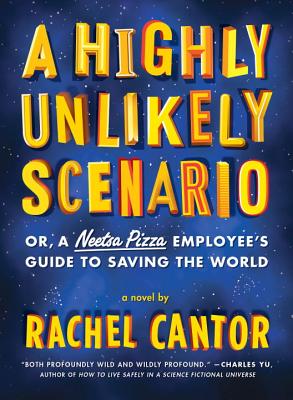
This week, I had the pleasure of reading four novels — three recent, one older — in which styles and genres that one might not expect to collide are brought together. Sometimes this is ornately constructed; for others, the approach seems to have been to place disparate elements in close proximity and see what emerges.
Rachel Cantor’s A Highly Unlikely Scenario is set in the kind of near future in which the shitty jobs of today have become even shittier, and sinister corporations loom large. That said, Cantor’s approach here is decidedly idiosyncratic: there are warring philosophical schools, each of which has its own fast food chain; there’s a heavy dose of Jewish mysticism; and there are numerous riffs on the concept of the brazen head. (Plus artificial intelligences, time travel, and other nominally more familiar concepts.) As someone who’s published one of Cantor’s stories, I may not be the most neutral party here, but I found myself enjoying the way the narrative leapt from concept to concept, with a likeable set of characters at its heart.
There are just as many high concepts found in Sam Thompson’s Communion Town, though there the structure seems more deliberate. The city that gives the book its title is a surreal place, and each of the ten chapters illuminates a different facade of it, from ghost stories to an increasingly-more-surreal private eye yarn to a Holmesian pastiche. The opening chapter sets up the basic geography of the city, and also establishes the blurredness of Thompson’s approach to realism. As a reader with a fondness for tales of cities that blend into the surreal — think Dhalgren, think Amnesia Moon — this one hit my sweet spot, even if some of the stories told herein impressed me more than others.
Stephen Graham Jones is a writer whose name I’ve heard mentioned a lot; he seems to fall into the odd cross-section of literary craftsmanship and visceral horror where you’ll find a lot of Brian Evenson’s work. His novel The Least of My Scars was the first book of his I’ve read — though I also have The Fast Red Road on my to-read shelf. It’s the story of a serial killer residing in a particularly stylized building; the tale of how he came to be there and the slow unraveling of his mind make up the bulk of the book. If you like your unreliable narrators particularly unsavory, you’ll find that here. It’s a grim descent into an already-unpleasant mind, memorably documented.
I hadn’t read anything by Muriel Spark in a while, and so I took her short novel The Driver’s Seat with me on my commute one morning. Like her Not to Disturb, it’s written in a somewhat breezy style that masks horrors and repression running throughout the narrative. Lise, the novel’s protagonist, travels to southern Europe on what seems to be a routine holiday; via a few choice nods in the narrative, we glean early on that her trip has a far more sinister destination. Her forcefulness exists in sharp contrast to the sometimes sinister and sometimes bumbling characters that she encounters on her way. And I’m just learning that it was made into a film starring Elizabeth Taylor in 1974, which I suspect I’ll have to rent before long.
Follow Vol. 1 Brooklyn on Twitter, Facebook, Google +, our Tumblr, and sign up for our mailing list.
